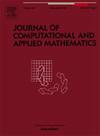Regularized Nesterov’s accelerated damped BFGS method for stochastic optimization
IF 2.1
2区 数学
Q1 MATHEMATICS, APPLIED
Journal of Computational and Applied Mathematics
Pub Date : 2025-03-05
DOI:10.1016/j.cam.2025.116616
引用次数: 0
Abstract
A regularization term is introduced into the approximate Hessian update in the stochastic Broyden–Fletcher–Goldfarb–Shanno (BFGS) method for convex stochastic optimization problems to help avoid near-singularity issues. Additionally, Nesterov acceleration, with a momentum coefficient that dynamically adjusts between a constant value and zero based on the objective function, has been incorporated to enhance convergence speed. However, the inflexibility of the constant momentum coefficient still may lead to overshooting problems, and evaluating objective functions on large datasets is computationally costly. Moreover, this approach presents challenges in solving nonconvex optimization problems. To address these challenges, we propose a regularized stochastic BFGS method that integrates Nesterov acceleration with an adaptive momentum coefficient designed for solving nonconvex stochastic optimization problems. This coefficient adjusts flexibly between a decreasing value and zero based on selected dataset samples, helping to avoid overshooting problems and reduce computational costs. We demonstrated almost sure convergence to stationary points and analyze the complexity. Numerical results on convex and nonconvex classification problems using a support vector machine show that our method outperforms existing approaches.

随机优化的正则Nesterov加速阻尼BFGS方法
在求解凸随机优化问题的随机Broyden-Fletcher-Goldfarb-Shanno (BFGS)方法的近似Hessian更新中引入正则化项,避免了近奇点问题。此外,还加入了Nesterov加速度,其动量系数根据目标函数在常数和零之间动态调整,以提高收敛速度。然而,恒定动量系数的不灵活性仍然可能导致超调问题,并且在大型数据集上评估目标函数的计算成本很高。此外,这种方法在解决非凸优化问题时提出了挑战。为了解决这些挑战,我们提出了一种正则化随机BFGS方法,该方法将Nesterov加速度与自适应动量系数集成在一起,旨在解决非凸随机优化问题。该系数根据选定的数据集样本在递减值和零之间灵活调整,有助于避免超调问题并降低计算成本。我们证明了该算法收敛于平稳点几乎是肯定的,并分析了其复杂性。用支持向量机对凸和非凸分类问题的数值计算结果表明,该方法优于现有方法。
本文章由计算机程序翻译,如有差异,请以英文原文为准。
求助全文
约1分钟内获得全文
求助全文
来源期刊
CiteScore
5.40
自引率
4.20%
发文量
437
审稿时长
3.0 months
期刊介绍:
The Journal of Computational and Applied Mathematics publishes original papers of high scientific value in all areas of computational and applied mathematics. The main interest of the Journal is in papers that describe and analyze new computational techniques for solving scientific or engineering problems. Also the improved analysis, including the effectiveness and applicability, of existing methods and algorithms is of importance. The computational efficiency (e.g. the convergence, stability, accuracy, ...) should be proved and illustrated by nontrivial numerical examples. Papers describing only variants of existing methods, without adding significant new computational properties are not of interest.
The audience consists of: applied mathematicians, numerical analysts, computational scientists and engineers.

 求助内容:
求助内容: 应助结果提醒方式:
应助结果提醒方式:


